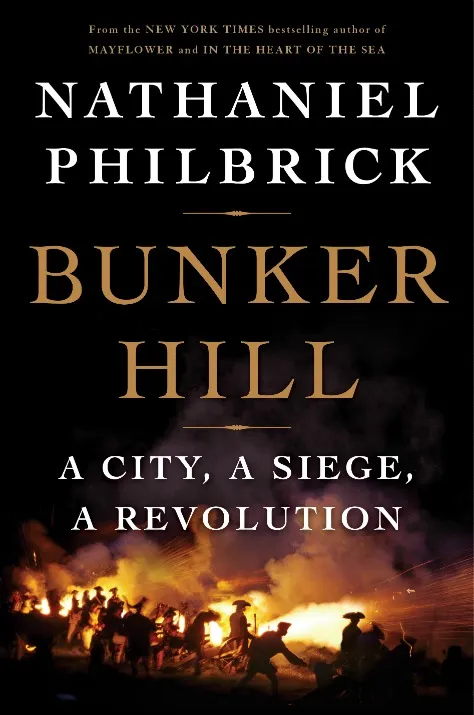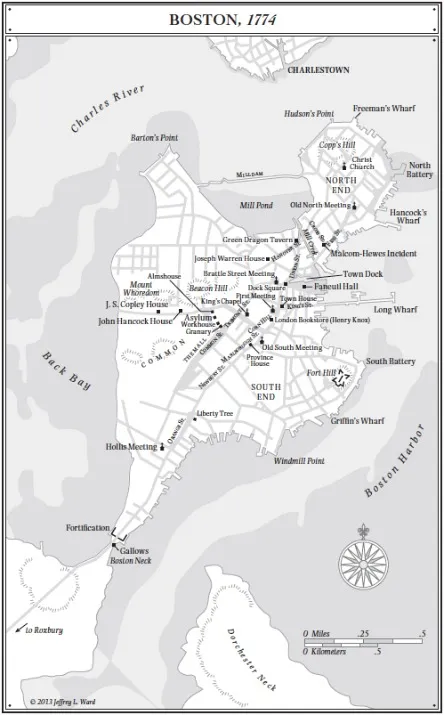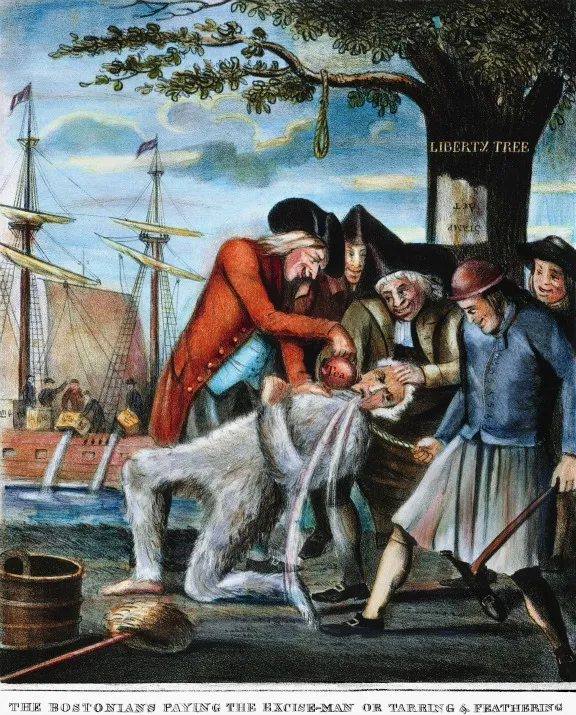The Worst Parade to Ever Hit the Streets of Boston
On the eve of the Revolutionary War, loyalist John Malcom was tarred, feathered and dragged through the streets, just for arguing with a young boy
/https://tf-cmsv2-smithsonianmag-media.s3.amazonaws.com/filer/john-malcom-631.png)
This tale is excerpted from Nathaniel Philbrick's upcoming book Bunker Hill: A City, A Siege, A Revolution, available for pre-order now and in stores on April 30, 2013.
Boston had always been a town on tiptoe. Just a square mile in area, with a mere sliver of land connecting it to the mainland to the south, this tadpole-shaped island was dominated by three towering, lightly settled hills and a virtual forest of steeples. From Boston’s highest perch, the 138-foot Beacon Hill, it was possible to see that the town was just one in a huge amphitheatre of humped and jagged islands that extended more than eight and a half miles to Point Allerton to the southeast. Whether it was from a hill, a steeple, or a cupola, Bostonians could plainly see that they were surrounded by two deep and endless wildernesses: the ocean to the east and the country to the west.
Boston’s topography contributed to the seemingly nonsensical pattern of its streets. Rather than follow any preconceived grid, the settlement’s original trails and cart paths had done their best to negotiate the many hills and hollows, cutting across the slopes at gradual angles to create a concave crescent of settlement within which more than fifty wharves and shipyards extended from the town’s eastern edge.
It was in winter that this city of hills came into its own—at least if you were a boy. Streets normally crowded with people, horses, ox carts, and carriages became, thanks to a coating of snow and ice, magical coasting trails down which a youngster on his wooden sled could race at startling and wonderful speeds. On January 25, 1774, there were at least two feet of snow covering Boston. Runner-equipped sleighs glided across roads that carts and chaises had once plodded over, moving so silently across the white drifts that tinkling bells were added to the horses’ halters so that the people of Boston could hear them coming. The boys in theirs sleds did not have this luxury, however, and that afternoon a child approaching the end of his run down Copp’s Hill in the North End slammed into the 50-year-old customs officer John Malcom—that is, at least, according to one account. Another account has Malcom falling into an argument with the boy when the child complained that Malcom had ruined the coasting run that passed by his front door by throwing woodchips on the snow.
Malcom, as his vocation as a customs agent might suggest, was a loyalist; he also had a reputation for losing his temper. Raising his cane in the air as if to strike the boy, he shouted, “Do you talk to me in that style, you rascal!” It was then that George Hewes, a shoemaker, came upon them standing at the mouth of Cross Street.
Hewes had recently participated in the Tea Party and was known to be a patriot. But at this point, political beliefs were of little concern to him; he was worried that Malcom might injure the defenseless boy and told him to leave the child alone.
Malcom turned to Hewes and accused him of being a “vagabond” who should not presume to speak to a gentleman such as himself. Besides commanding a host of coasting vessels, Malcom had served as an officer in several campaigns during the French and Indian War; he’d also fought more recently in what was known as the War of Regulation in North Carolina, where he’d assisted Royal Governor Tyrone in brutally suppressing an uprising of citizens who objected to the taxation system then prevalent in this portion of the South. Malcom claimed to have had two horses shot out from underneath him in North Carolina and later wrote in a petition to the king that “none could go further in the field of battle when the bullets flew thickest, he was then in his element.”
Malcom’s love of combat had recently gotten him into some serious professional trouble. Earlier that fall, while serving in the customs office in Falmouth (now Portland), Maine, he’d seized a ship and her 30-man crew under the slimmest of pretexts. His pompous and overbearing manner had so angered the sailors that they’d disarmed him of his sword and provided him with a “genteel” coat of tar and feathers—genteel in that they’d left his clothes on to protect his skin from the hot tar. Malcom had been humiliated but apparently not hurt, and even his superior officer at the customs office had had little sympathy for him. By that snowy day in January, Malcom was back home in Boston and arguing with not only a surly boy with a sled but this prying shoemaker as well.
Hewes was unimpressed by Malcom’s claims of social superiority, especially given what had happened to the customs agent in Maine, a story that had been repeated with great relish in Boston’s many newspapers. “Be that as it will,” Hewes replied to Malcom’s rebuke, “I never was tarred and feathered anyhow.”
This was too much for Malcom, who took up his cane and smashed Hewes in the head, ripping a two-inch gash in his hat and knocking him unconscious. When Hewes came to his senses, a Captain Godfrey was admonishing Malcom, who soon decided that it was in his best interests to beat a hasty retreat to his home on Cross Street.
All that afternoon word of the incident circulated through the streets of Boston. By eight o’clock in the evening, an angry crowd had assembled outside Malcom’s house. By that time Hewes had visited Dr. Joseph Warren, just across the Mill Bridge on nearby Hanover Street. Both a physician and a distant relative, Warren had told him that if it weren’t for his extraordinarily thick skull, Hewes would be a dead man. On Warren’s advice, he applied to a town official for a warrant for Malcom’s arrest, but it was now looking like a different kind of justice was about to be served.
Earlier in the evening, Malcom had taken a manic delight in baiting the crowd, bragging that Governor Hutchinson would pay him a bounty of 20 pounds sterling for every “yankee” that he killed. His undoubtedly longsuffering wife, the mother of five children (two of whom were deaf), opened a window and pleaded with the townspeople to leave them alone. Whatever sympathy she had managed to gain soon vanished when Malcom pushed his unsheathed sword through the window and stabbed a man in the breastbone.
The crowd swarmed around the house, breaking windows and trying to get at the customs official, who soon fled up the stairs to the second story. Many Bostonians served as volunteer firemen, and it wasn’t long before men equipped with ladders and axes were rushing toward the besieged house on Cross Street. Even Malcom appears to have realized that matters had taken a serious turn, and he prepared “to make what defense he could.”
Collective violence had been a longstanding part of colonial New England. Crowds tended to intervene when government officials acted against the interests of the people. In 1745, a riot had broken out in Boston when a naval press gang seized several local sailors. Twenty-three years later, anger over the depredations of yet another press gang contributed to the Liberty Riot of 1768, triggered by the seizure of John Hancock’s ship of the same name by Boston customs officials. In that the crowds were attempting to address unpunished wrongs committed against the community, they were a recognized institution that all Bostonians—no matter how wealthy and influential they might be—ignored at their peril. On August 26, 1765, as outrage over the Stamp Act swept across the colonies, a mob of several hundred Bostonians had attacked the home of Lieutenant Governor Thomas Hutchinson, breaking windows, beating down doors, and ransacking the house of its elaborate furnishings. But as John Malcom was about to find out on that frigid night in January 1774, and as Thomas Hutchison had learned almost a decade before him, the divide between a civic-minded crowd and an unruly and vindictive mob was frighteningly thin.
***
Malcom and his family huddled in their home’s second floor. A locked door stood between them and the angry crowd down below. They heard the thud of the ladders against the sides of the house and the cries of the men and boys as they climbed up to the second-story windows and punched through the glass. It was then that “a Mr. Russell,” perhaps William Russell, an usher (or teaching assistant) at a school on Hanover Street, appeared inside the house. Smiling broadly, he assured Malcom that he came in friendship and shook the customs officer’s hand. He then asked if he could see Malcom’s sword. Desperate for whatever assistance he could find, Malcom reluctantly handed over the weapon, only to watch as Russell (who, if he indeed was William Russell, had participated in the Tea Party) called out to the others in the house that Malcom was now unarmed. “They immediately rushed in,” Malcom wrote, “and by violence forced your memorialist out of the house and beating him with sticks then placed him on a sled they had prepared.” One can only wonder what Mrs. Malcom and her sons and daughters were thinking as they watched him disappear into the unlit streets of Boston.
After a stop at a nearby wharf to pick up a barrel of tar (at some point, down-filled pillows, perhaps taken from Malcom’s own house, were also collected), the crowd, which now numbered more than a thousand people, hauled Malcom through the snowy streets to the center of town, where after three “Huzzas,” they loaded him into a cart parked in front of the Customs House. Almost four years before, this had been the site of the Boston Massacre, and as a consequence the building was now referred to as Butchers’ Hall. Bonfires were common in this portion of King Street, a 60-foot-wide plaza-like space in front of the Town Hall paved with seashells and gravel where the stocks and whipping post were also located. One of these fires may have been used to heat the stiff and sludgy pine tar (a distillation of the bituminous substance that bubbled from a smoldering pine tree) into a pourable black paste.
It was one of the bitterest evenings of the year. Boston Harbor had frozen over two nights before. Malcom was undoubtedly trembling with cold and fear, but this did not prevent the crowd from tearing off his clothes (dislocating his arm in the process) and daubing his skin with steaming tar that would have effectively parboiled his flesh. Once the feathers had been added, Malcom was clothed in what was known at the time as a “modern jacket”: a painful and mortifying announcement to the world that he had sinned against the collective mores of the community. Tarring and feathering went back centuries to the time of the crusades; it was also applied to the effigies used during Pope Night; several Boston loyalists before him had been tarred and feathered, but none could claim the level of suffering that Malcom was about to endure.
Soon the crowd began pushing Malcom’s cart up King Street toward the Town House, the cupola-topped brick building emblazoned with the king’s seal that was the home of the colony’s legislature. Once passed the Town House, they turned left onto Boston’s main thoroughfare, known in this portion of the city as Cornhill. With the three-story brick edifice of Boston’s first Congregational Meeting, referred to as the Old Meeting, on their right, they made their way through a gauntlet of tightly packed buildings of varying heights. Lights flared in the windows as they passed, the crowd’s shouts and whistles washing across the brick and clapboard facings and echoing up into the hills to the right, where the almshouse, the asylum for the “disorderly and insane,” the workhouse, and the granary overlooked the rolling 45-acre sweep of the Common.
Cornhill became Marlborough Street by the time they reached the block containing the governor’s official residence, Province House. On the cupola of this stately, three-story brick structure was a copper weathervane depicting an Indian with an arrow in his bow. When the wind was from the east, the Province House Indian seemed to be aiming at the even higher weathercock on the spire of the Old South Meetinghouse just across the street. The crowd stopped between these two soaring buildings and ordered Malcom to curse Governor Hutchinson (who was safely ensconced at his country house ten miles away in Milton that night) and “say he was an enemy to his country.” Malcom steadfastly refused.
On they proceeded through the freezing darkness, the cart’s wheels crunching through the snow. They were now in the heart of the South End, the more affluent side of town, where Marlborough turned into Newbury Street. At the corner of Essex on their left, they stopped at the huge old elm known as the Liberty Tree. A staff rose up out of the topmost portion of the tree’s trunk on which a flag was often flown. This was where the first protests against the Stamp Act had been held back in 1765, and in the years since, the Liberty Tree had become a kind of druidical, distinctly American shrine to the inherent freedoms of man and that Enlightenment sense of “the state of nature” that exists before a people willingly submit to the dictates of a government of their own choosing.
On this cold night, the people of Boston were directing their anger against a man who resolutely, even fanatically insisted that they must defer to a distant king and a legislature that no longer respected their God-given rights, that obedience must be paid not only to their royal sovereign but to a man like John Malcom: a bitter and grasping underling whose world was crumbling beneath him. Malcom stood in the cart below the tree’s bare winter branches and once again refused to curse the governor.
They continued down Newbury to where it became Orange Street. Soon they were approaching the town gate at Boston Neck, more than a mile from the Town House. The old brick fortification dated back to King Philip’s War, when Boston had become a refuge for those attempting to escape the Indians, and once through the gate, they were out onto the thin strand of wave-washed earth that connected Boston to the town of Roxbury. On either side of them, the icy marshes and shallows extended out into darkness. On the left, just past the gate was the gallows.
They placed a rope around Malcom’s neck and threatened to hang him if he would not do as they’d previously ordered. By this time the tar had congealed into a frozen crust; his body’s inner core had probably become so chilled that he no longer had the ability to tremble. Once again, he refused to curse the governor, but this time he asked that they would “put their threats into execution rather than continue their torture.”
They took the rope off Malcom’s neck, pinioned his hands behind his back and tied him to the gallows. Then they began to beat him with ropes and sticks “in a most savage manner.” According to one account they even threatened to cut off his ears. At last, he said he would do “anything they desired.” They untied him and made him curse the governor and the Customs board of commissioners. But his sufferings were not over.
For several more hours they continued to parade Malcom through the streets of Boston. Not everyone shared in the crowd’s pitiless delight; a few people, including the man whose intervention had started this horrifying concatenation of events, the shoemaker George Hewes, were so appalled by Malcom’s treatment that they attempted to cover him with their jackets.
By the time the crowd reached Copp’s Hill near Malcom’s home in the North End, he must have passed out, for he makes no mention of this final stop, which is described in several newspaper accounts. Here, in the cemetery near the summit of the hill, was the grave of Malcom’s younger brother Daniel. Daniel appears to have had the same fiery personality as his brother. Whereas John became a customs agent; Daniel sided with the opposite, more popular camp, famously barricading himself in his house in 1766 to prevent the crown’s agents from finding the smuggled wine he had supposedly hidden in his cellar. When Daniel died in 1769 at the age of 44, he was a patriot hero, and the inscription on his gravestone described him as “a true son of Liberty / a Friend to the Publick / an Enemy to oppression / and one of the foremost / in opposing the Revenue Acts / on America.”
Daniel had been celebrated for breaking the laws of his day. That night in January 1774, his loyalist brother John sat slumped in a chair that someone had placed inside the cart. It was true that he was obnoxious and impulsive, that he’d virtually invited the treatment he’d received. But the fact remained that this “enemy of the people” had been scalded, frozen, and beaten to within an inch of his life not because he’d taken a swipe at a shoemaker but because he upheld the unpopular laws that his brother had scorned. It had been a brutal, even obscene display of violence, but the people of Boston had spoken.
Around midnight, the crowd finally made its way back to Malcom’s house on Cross Street, where he was “rolled out of the cart like a log.” Once he’d been brought back into the house and his frozen body had begun to thaw, his tarred flesh started to peel off in “steaks.” Although he somehow found the strength to make a deposition five days later, it would take another eight weeks before he could leave his bed.
Later that year Malcolm sailed for London with hopes of securing compensation for what he’d suffered at the hands of the Boston mob. In addition to a detailed petition, he brought along a wooden box containing the ultimate trophy: a withered hunk of his own tarred-and-feathered flesh.
On January 12, 1775, he attended the levee at St. James’s, where he knelt before King George III and handed his majesty a petition. What Malcom wanted more than anything else, he informed the king, was to return to Boston and resume his duties as a customs official—but not as just any customs official. He wanted to be made “a single Knight of the Tar…for I like the smell of it.”
From the book Bunker Hill: A City, A Siege, A Revolution by Nathaniel Philbrick to be published later this month by Viking. Copyright © 2013 by Nathaniel Philbrick






